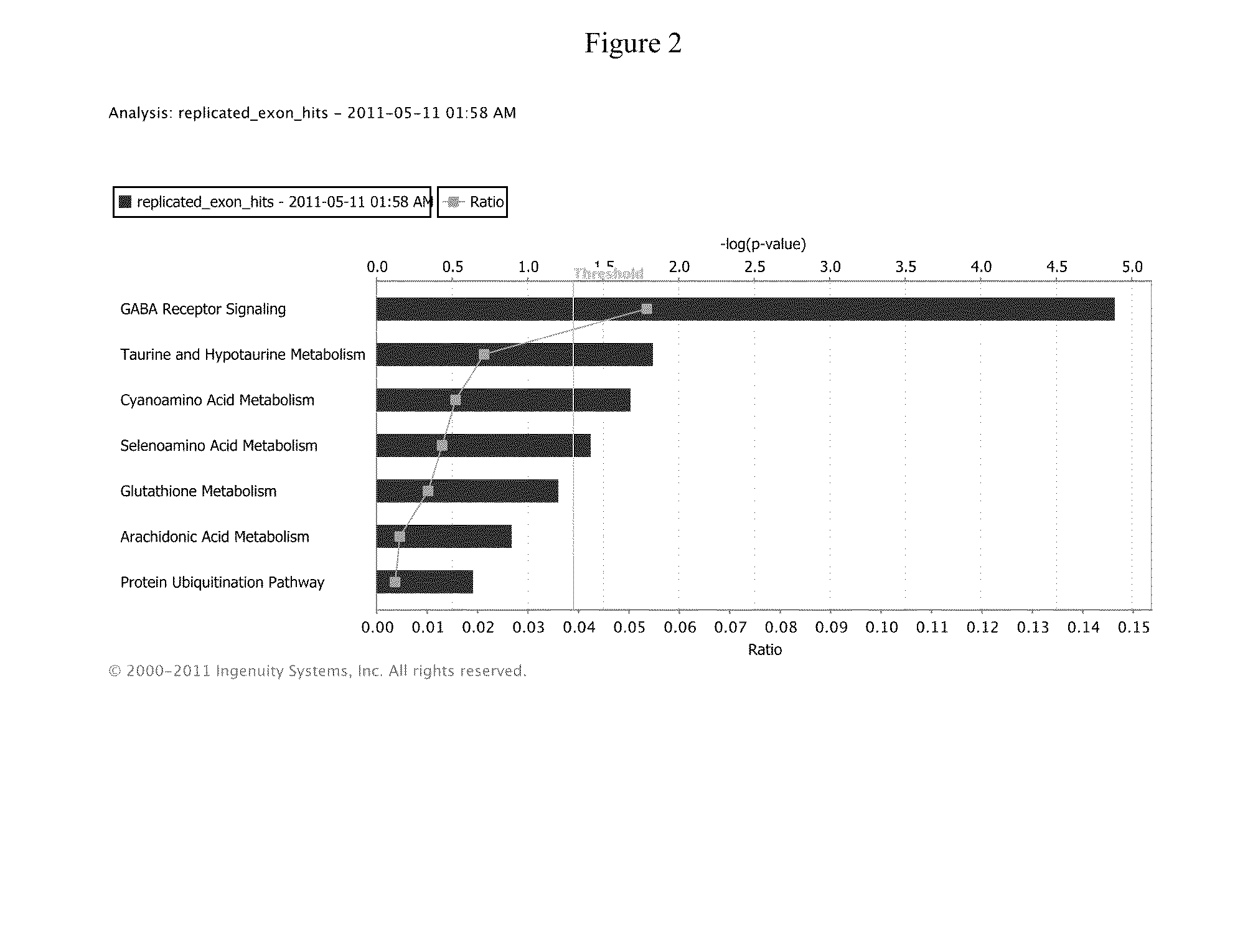Genetic Alterations Associated with Autism and the Autistic Phenotype and Methods of Use Thereof for the Diagnosis and Treatment of Autism
a genetic alterations and autism technology, applied in the field of genetics and the diagnosis and treatment of autism and autism spectrum disorders, can solve the problems of lack of awareness, social imitation and symbolic play difficulties, and a huge economic burden on society
- Summary
- Abstract
- Description
- Claims
- Application Information
AI Technical Summary
Benefits of technology
Problems solved by technology
Method used
Image
Examples
example i
[0106]The ability to quantify individual's genomic risk for disease can facilitate the development of new interventions and improve medical practice. Many rare Copy
[0107]Number Variants (CNVs) that harbor small genomic deletions and insertions have been described in the autism spectrum disorders (ASD). To identify these likely functional elements, we combined various large cohorts of autistic patients with a large number of neurologically normal controls to analyze over 3K affected cases and 7K controls. In a two-stage genome-wide association design, we uncovered 266 genome-wide statistically significant (combined P−8) distinct CNV regions (CNVR).
[0108]The 38 genes with exons disrupted by these robust CNVRs are most enriched in gene networks impacting neurological disease, behavior and developmental disorder. GABAR-A receptor signaling was found to be the most significant canonical pathways disrupted in ASD because case-enriched defects in GABRA5, GABRB3, and GABRG3 genes. Moreover,...
example ii
Screening Assays for Identifying Efficacious Therapeutics for the Treatment of Autism and ASD
[0116]The information herein above can be applied clinically to patients for diagnosing an increased susceptibility for developing autism or autism spectrum disorder and therapeutic intervention. A preferred embodiment of the invention comprises clinical application of the information described herein to a patient. Diagnostic compositions, including microarrays, and methods can be designed to identify the genetic alterations described herein in nucleic acids from a patient to assess susceptibility for developing autism or ASD. This can occur after a patient arrives in the clinic; the patient has blood drawn, and using the diagnostic methods described herein, a clinician can detect a CNV as described in Example I and set forth in Table II. The information obtained from the patient sample, which can optionally be amplified prior to assessment, will be used to diagnose a patient with an increas...
example iii
REFERENCES FOR EXAMPLE III
[0151]1. Muhle R, Trentacoste S V, Rapin I (2004) The genetics of autism. Pediatrics 113: e472-86. Available: http: / / www.ncbi.nlm.nih.gov / pubmed / 15121991. Accessed 4 Jun. 2011.[0152]2. Fombonne E (2003) The prevalence of autism. JAMA 289: 87-89. Available: http: / / www.ncbi.nlm.nih.gov / entrez / query.fcgi?cmd=Retrieve&db=PubMed&dopt=Citati on&list_uids=12503982.[0153]3. Prevalence of autism spectrum disorders—autism and developmental disabilities monitoring network, 14 sites, United States, 2002. (2007). MMWR Surveill Summ Morb Mortal Wkly report Surveill Summ / CDC 56: 12-28. Available: http: / / www.ncbi.nlm.nih.gov / pubmed / 17287715. Accessed 6 Jun. 2011.[0154]4. Prevalence of autism spectrum disorders—Autism and Developmental Disabilities Monitoring Network, United States, 2006. (2009). MMWR Surveill Summ Morb Mortal Wkly report Surveill Summ / CDC 58: 1-20. Available: http: / / www.ncbi.nlm.nih.gov / pubmed / 20023608. Accessed 21 Feb. 2011.[0155]5. Blumberg S J, Ph D, Br...
PUM
| Property | Measurement | Unit |
|---|---|---|
| Size | aaaaa | aaaaa |
Abstract
Description
Claims
Application Information
 Login to View More
Login to View More - R&D
- Intellectual Property
- Life Sciences
- Materials
- Tech Scout
- Unparalleled Data Quality
- Higher Quality Content
- 60% Fewer Hallucinations
Browse by: Latest US Patents, China's latest patents, Technical Efficacy Thesaurus, Application Domain, Technology Topic, Popular Technical Reports.
© 2025 PatSnap. All rights reserved.Legal|Privacy policy|Modern Slavery Act Transparency Statement|Sitemap|About US| Contact US: help@patsnap.com



